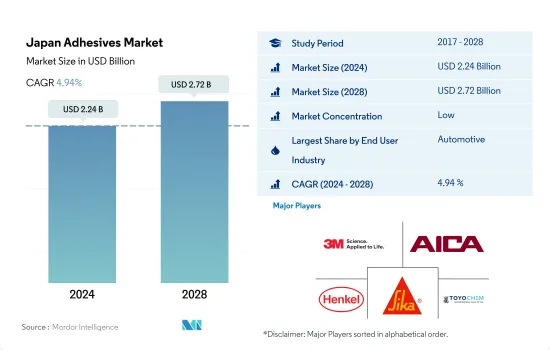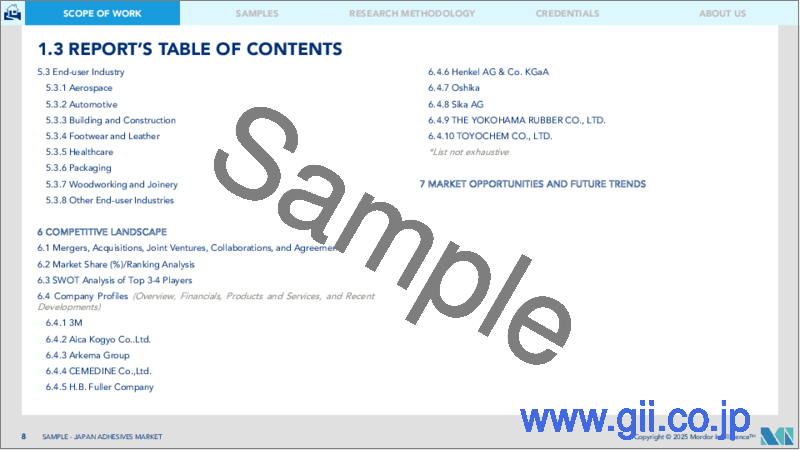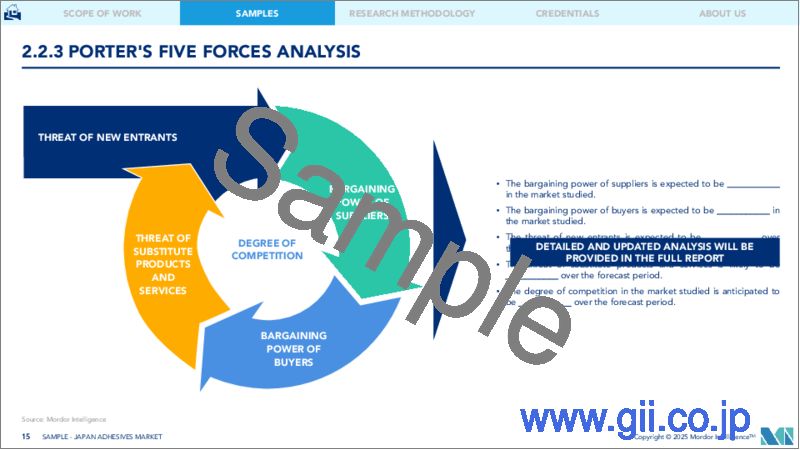|
|
市場調査レポート
商品コード
1693372
日本の接着剤:市場シェア分析、産業動向と統計、成長予測(2025年~2030年)Japan Adhesives - Market Share Analysis, Industry Trends & Statistics, Growth Forecasts (2025 - 2030) |
||||||
カスタマイズ可能
適宜更新あり
|
|||||||
価格
| 日本の接着剤:市場シェア分析、産業動向と統計、成長予測(2025年~2030年) |
|
出版日: 2025年03月18日
発行: Mordor Intelligence
ページ情報: 英文 208 Pages
納期: 2~3営業日
|
- 全表示
- 概要
- 目次
概要
日本の接着剤市場規模は2024年に22億4,000万米ドルと推定・予測され、2028年には27億2,000万米ドルに達し、予測期間中(2024~2028年)にCAGR 4.94%で成長すると予測されます。

新興自動車市場と建築・建設産業が日本の接着剤消費を押し上げると予想されます。
- 日本では、接着剤は主に包装、自動車、建築・建設、医療産業で使用されています。日本における接着剤の消費は、COVID-19パンデミックの影響により2020年には減少しました。2020年の需要は2019年に比べ数量ベースで11%減少しました。約半年間にわたる国内での封鎖により生産設備が停止し、原料が不足したことが、日本における接着剤の生産と消費が減少した主要理由です。
- 日本の自動車産業は世界第3位であり、22都道府県に78のメーカーがあり、550万人以上の従業員が働いています。日本経済の重要な柱です。自動車製造業は日本最大の産業部門(輸送機械産業)の89%を占め、自動車部品メーカーは日本経済の重要な部分を占めるようになり、化学やゴムなど他の産業にも進出しています。高度に革新的で技術志向のビジネスであり、電気自動車やハイブリッド車の生産が国内と世界市場で増加し、世界的規模で需給が拡大しています。
- 日本の建設産業の予後は、ここ数年来で最も良好です。日本政府は、多くの公共事業によって国内景気を押し上げることを約束しました。この公約は、2020年のオリンピックや2025年の大阪万博といった大型イベントの準備に促されたものです。日本全土で基幹産業が成長していることから、予測期間中に接着剤の需要が増加すると予想されます。
日本の接着剤市場動向
プラスチックのリサイクル性の先進包装と飲食品産業からの需要で、プラスチック包装が包装産業をリードへ
- 日本の包装産業は近年著しい成長を遂げ、製品の安全性と長寿命を保護・強化する傾向の高まりにより、国内総生産(GDP)に1.13%寄与しています。飲食品セクタは、その複雑で進化する性質により、日本の包装産業に大きなシェアを占めています。日本政府は、2025年までに食品自給率45%を達成するという目標を掲げており、今後数年間、包装産業に貢献する可能性が高いです。さらに、高齢化社会は、高齢の消費者が簡単に手に入る包装食品や調理済み食品を好むため、包装需要を促進すると予想されます。
- COVID-19パンデミックに伴い、国全体の封鎖と製造施設の一時的な操業停止は、サプライチェーンや輸出入の混乱を含むいくつかの問題を引き起こしました。その結果、2020年の同国の包装生産量は前年比6%減となり、市場に大きな影響を与えました。同国の包装生産は主にプラスチック包装が牽引しており、2021年に生産される包装の約86%を占めています。さまざまな用途向けの軟質と硬質包装に対する需要の高まりとプラスチックリサイクルの先進化により、プラスチック生産部門は予測期間中にCAGR 3.94%を記録し、最速の成長を遂げる可能性が高いです。
- 日本の包装産業の成長は、主に一人当たり所得の増加、サプライチェーンの改善、eコマース活動の増加によるものです。パンデミック後の全国的な食の安全性と品質への関心の高まりは、食品加工産業を牽引し、今後数年間の包装需要をさらに促進すると考えられます。
トヨタ、ホンダ、日産を含む有名自動車メーカーの本拠地であることに加え、EVの需要が自動車産業を押し上げています。
- 日本にはトヨタ、ホンダ、日産といった世界最大の自動車メーカーがあり、中でもトヨタは時価総額で世界第2位の企業です。トヨタの2022年3月期の売上高は前年同期比15%増を示し、日本における自動車市場の成長動向の高まりを示唆しています。日本の乗用車販売台数は2027年までに395万1,710台に達すると予想されます。
- COVID-19パンデミックの影響により、全国的な封鎖、全体的な景気減速、輸出の減少、サプライチェーンの混乱等により、自動車の販売は大幅に減少しました。これらの要因により、乗用車販売台数は2019年の399万7,000台から2020年には384万1,000台に減少し、2020年の自動車販売台数は減少しました。
- 日本では、環境問題に対する意識の高まりと、日本の都市部における公共輸送の利用増加により、2021年の自動車市場の売上高は2020年に比べて減少しました。政府も公共輸送を以前より効率的にすることでこの原因を支援しています。日本の公共輸送の72%近くを鉄道が占めています。
- 日本では2017年に電気自動車の販売台数がピークに達したが、これは消費者にアピールした新しいプラグインハイブリッド車の発売によるものです。自動車産業の電気自動車セグメントは、2022~2027年に24.39%のCAGRで推移すると予想されます。日本で販売される電気自動車の台数は、2027年までに16万5,500台になると予想されます。これは日本の自動車産業全体の収益の増加につながります。
日本の接着剤産業概要
日本の接着剤市場はセグメント化されており、上位5社で25.89%を占めています。この市場の主要企業は、3M、Aica Kogyo、Henkel AG & Co. KGaA、Sika AG、TOYOCHEMなどです。
その他の特典
- エクセル形式の市場予測(ME)シート
- 3ヶ月のアナリストサポート
目次
第1章 エグゼクティブサマリーと主要調査結果
第2章 レポートのオファー
第3章 イントロダクション
- 調査の前提条件と市場定義
- 調査範囲
- 調査手法
第4章 主要産業動向
- エンドユーザー動向
- 航空宇宙
- 自動車
- 建築・建設
- フットウェア皮革
- 包装
- 木工・建具
- 規制の枠組み
- 日本
- バリューチェーンと流通チャネル分析
第5章 市場セグメンテーション
- エンドユーザー産業
- 航空宇宙
- 自動車
- 建築・建設
- フットウェアと皮革
- 医療
- 包装
- 木工・建具
- その他
- 技術
- ホットメルト
- 反応性
- 溶剤系
- UV硬化型接着剤
- 水性
- 樹脂
- アクリル系
- シアノアクリレート
- エポキシ
- ポリウレタン
- シリコーン
- VAE・EVA
- その他
第6章 競合情勢
- 主要な戦略動向
- 市場シェア分析
- 企業情勢
- 企業プロファイル
- 3M
- Aica Kogyo Co..Ltd.
- Arkema Group
- CEMEDINE Co.,Ltd.
- H.B. Fuller Company
- Henkel AG & Co. KGaA
- Oshika
- Sika AG
- THE YOKOHAMA RUBBER CO., LTD.
- TOYOCHEM CO., LTD.
第7章 CEOへの主要戦略的質問
第8章 付録
- 世界の接着剤・シーラント産業概要
- 概要
- ファイブフォース分析フレームワーク(産業魅力度分析)
- 世界のバリューチェーン分析
- 促進要因、抑制要因、機会
- 情報源と参考文献
- 図表一覧
- 主要な洞察
- データパック
- 用語集
目次
Product Code: 92427
The Japan Adhesives Market size is estimated at 2.24 billion USD in 2024, and is expected to reach 2.72 billion USD by 2028, growing at a CAGR of 4.94% during the forecast period (2024-2028).

Emerging automotive market and building & construction industry expected to boost the consumption of adhesives in Japan
- In Japan, adhesives are largely used across the packaging, automotive, building and construction, and healthcare industries. The consumption of adhesives in Japan declined in 2020 due to the impact of the COVID-19 pandemic. Demand fell by 11% in terms of volume in 2020 compared to 2019. The lockdown in the country for nearly six months, which resulted in the shutdown of production facilities and raw material shortage, is the major reason behind the decline in adhesives production and consumption in Japan.
- The Japanese automobile industry is the third-largest globally, with 78 manufacturers in 22 prefectures employing over 5.5 million people. It is a vital pillar of the country's economy. Automotive manufacturing accounts for 89% of Japan's largest industrial sector (the transportation machinery industry), and car components suppliers have become a significant part of the Japanese economy, expanding into other industries such as chemicals and rubber. It is a highly innovative and technologically oriented business, with rising production of electric and hybrid vehicles in local and worldwide markets, as well as a growth in supply and demand on a global scale.
- The prognosis for Japan's construction industries is better than it has been in years. The Japanese government has promised to boost the domestic economy with many public works projects. This commitment was prompted by its preparations for major events such as the 2020 Olympics and the 2025 World Expo in Osaka. The growing core industries across Japan are expected to increase the demand for adhesives over the forecast period.
Japan Adhesives Market Trends
With the advancement in plastic recyclability and demand from food and beverage industry, plastic packaging to lead the packaging industry
- The Japanese packaging industry registered significant growth in recent times and contributed 1.13% to the nation's GDP owing to the growing trend for protecting and enhancing products' safety and longevity. The food & beverages sector contributes a major share to the Japanese packaging industry due to its complex and evolving nature. The Japanese government has set a target of achieving 45% sufficiency of food products by 2025, likely contributing to the packaging industry over the coming years. Moreover, the aging population is expected to propel packaging demand as elderly consumers prefer packaged and prepared food for easy access.
- In line with the COVID-19 pandemic, the country-wide lockdowns and temporary shutdown of manufacturing facilities caused several issues, including disruptions to the supply chain and imports & exports. As a result, the country's packaging production declined by 6% in 2020 compared to the previous year, significantly affecting the market. Packaging production is majorly driven by plastic packaging in the country, which accounts for around 86% of the packaging produced in 2021. With the growing demand for flexible and rigid packaging for various applications and plastic recycling advancements, the plastic production segment is likely to register the fastest growth, with a 3.94% CAGR during the forecast period.
- The growth of the Japanese packaging industry is mainly attributed to the rising per capita income, improvement of the supply chain, and increasing e-commerce activities over the years. The growing attention to food safety and quality in post-pandemic times across the nation is likely to drive the food processing industry, which will further propel the packaging demand over the coming years.
In addition to being home to renowned automotive manufacturers including Toyota, Honda, and Nissan, the demand for EVs is rising the automotive industry
- Japan is home to the world's largest automotive companies, such as Toyota, Honda, and Nissan, of which Toyota is the world's second-largest company in terms of market capitalization. Toyota's sales revenue showed a 15% Y-o-Y growth in the fiscal year ending March 2022, suggesting an increasing trend of automotive market growth in Japan. Passenger vehicle sales in Japan are expected to reach 3951.71 thousand units by 2027.
- Due to the impact of the COVID-19 pandemic, the sales of automobiles reduced drastically because of nationwide lockdowns, overall economic slowdown, decreased exports, supply chain disruptions, etc. These factors led to a decrease in the sales volume of automobiles in 2020 as passenger car sales fell from 3997 thousand in 2019 to 3841 thousand in 2020.
- Japan witnessed a decrease in automotive market revenue in 2021 compared to 2020 because of the increasing awareness of environmental concerns and increased use of public transport in the cities of Japan. The government is also supporting the cause by making public transport more efficient than before. The railways cover nearly 72% of the public transportation system in Japan.
- Japan witnessed peak sales of electric vehicles in 2017 because of the launch of new plug-in hybrid vehicles, which appealed to consumers. The electric vehicles segment of the automotive industry is expected to record a CAGR of 24.39% in 2022-2027. The number of electric vehicles sold in Japan is expected to be 165.5 thousand by 2027. This will lead to an increase in the overall revenue of the automotive industry in Japan.
Japan Adhesives Industry Overview
The Japan Adhesives Market is fragmented, with the top five companies occupying 25.89%. The major players in this market are 3M, Aica Kogyo Co..Ltd., Henkel AG & Co. KGaA, Sika AG and TOYOCHEM CO., LTD. (sorted alphabetically).
Additional Benefits:
- The market estimate (ME) sheet in Excel format
- 3 months of analyst support
TABLE OF CONTENTS
1 EXECUTIVE SUMMARY & KEY FINDINGS
2 REPORT OFFERS
3 INTRODUCTION
- 3.1 Study Assumptions & Market Definition
- 3.2 Scope of the Study
- 3.3 Research Methodology
4 KEY INDUSTRY TRENDS
- 4.1 End User Trends
- 4.1.1 Aerospace
- 4.1.2 Automotive
- 4.1.3 Building and Construction
- 4.1.4 Footwear and Leather
- 4.1.5 Packaging
- 4.1.6 Woodworking and Joinery
- 4.2 Regulatory Framework
- 4.2.1 Japan
- 4.3 Value Chain & Distribution Channel Analysis
5 MARKET SEGMENTATION (includes market size in Value in USD and Volume, Forecasts up to 2028 and analysis of growth prospects)
- 5.1 End User Industry
- 5.1.1 Aerospace
- 5.1.2 Automotive
- 5.1.3 Building and Construction
- 5.1.4 Footwear and Leather
- 5.1.5 Healthcare
- 5.1.6 Packaging
- 5.1.7 Woodworking and Joinery
- 5.1.8 Other End-user Industries
- 5.2 Technology
- 5.2.1 Hot Melt
- 5.2.2 Reactive
- 5.2.3 Solvent-borne
- 5.2.4 UV Cured Adhesives
- 5.2.5 Water-borne
- 5.3 Resin
- 5.3.1 Acrylic
- 5.3.2 Cyanoacrylate
- 5.3.3 Epoxy
- 5.3.4 Polyurethane
- 5.3.5 Silicone
- 5.3.6 VAE/EVA
- 5.3.7 Other Resins
6 COMPETITIVE LANDSCAPE
- 6.1 Key Strategic Moves
- 6.2 Market Share Analysis
- 6.3 Company Landscape
- 6.4 Company Profiles (includes Global Level Overview, Market Level Overview, Core Business Segments, Financials, Headcount, Key Information, Market Rank, Market Share, Products and Services, and Analysis of Recent Developments).
- 6.4.1 3M
- 6.4.2 Aica Kogyo Co..Ltd.
- 6.4.3 Arkema Group
- 6.4.4 CEMEDINE Co.,Ltd.
- 6.4.5 H.B. Fuller Company
- 6.4.6 Henkel AG & Co. KGaA
- 6.4.7 Oshika
- 6.4.8 Sika AG
- 6.4.9 THE YOKOHAMA RUBBER CO., LTD.
- 6.4.10 TOYOCHEM CO., LTD.
7 KEY STRATEGIC QUESTIONS FOR ADHESIVES AND SEALANTS CEOS
8 APPENDIX
- 8.1 Global Adhesives and Sealants Industry Overview
- 8.1.1 Overview
- 8.1.2 Porter's Five Forces Framework (Industry Attractiveness Analysis)
- 8.1.3 Global Value Chain Analysis
- 8.1.4 Drivers, Restraints, and Opportunities
- 8.2 Sources & References
- 8.3 List of Tables & Figures
- 8.4 Primary Insights
- 8.5 Data Pack
- 8.6 Glossary of Terms
お電話でのお問い合わせ
044-952-0102
( 土日・祝日を除く )






